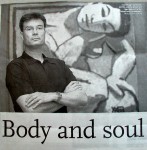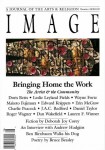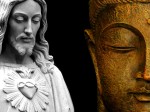Briefly describe your artistic style. What forces from both East and West have influenced what and how you create? What things are most appealing to you about each culture?
My artistic style might be described as expressionistic, narrative and figurative. It can be seen as a mixture of influences from the East where I was born (in the Philippines); from the Southern Hemisphere where I was married (in Brazil); and from the West where I was educated and reside today with my wife and four children (in Southern California).
From the East I retain a penchant for a loose calligraphic line that often extends even to the way I apply paint to the canvas. I love the sumi brush painters’ Zen-like idea of not assuming too much control over the medium, allowing it to express its own unique character – whether that is the flow of the paint or the strong graphic qualities of charcoal.
From the Latino painters like Diego Riveira, I learned to invest my figures with a monumentality that fills out the pictorial space. I am also drawn to constructing a picture as the great Mexican muralists do – sturdy and logical like a child with wooden building blocks.
From the West I retain many of the Modernist ideas that formed the basis of my university education. They give me an awareness of a constant questioning about the nature of the artistic enterprise, especially its conceptual component. I also appreciate the Modernist tradition of borrowing ideas from other cultures in order to revitalize the enterprise of art-making.
As an artist of faith what are some of the challenges you face? Is it easier for you to be a Christian in the East or in the West? Why?
It’s more difficult to be a Christian artist in the U.S. because here religion is so politicized and politics are so polarized. In the East and in Latin America one assumes that an artist belongs to a faith tradition and that that tradition is reflected in his work to a greater or lesser extent.
What sorts of collectors and viewers are interested in your work? What specifically engages them in your art? Are there markedly different responses to your work between Eastern and Western audiences?
I had a one-person show of figurative paintings at 10 Chancery Lane Gallery in Hong Kong about 7 years ago. About 12 paintings were sold, all to expats: Brits, French, Americans, Australians; not one was purchased by a Chinese. I was told that the Chinese don’t buy modern art, preferring to invest in objects that have intrinsic value like gold or jade. Also, they do not consider their home a showplace for art where they can receive visitors – entertaining is done in restaurants at big tables and home is a very casual and private place for family members only.
A few years earlier I had a one-person show in Makati, the upscale section of Manila. Here most of the buyers were from the wealthy Chinese-Filipino community. Only a few paintings did not sell and they were the ones that were considered “unlucky.” One featured a bunch of hot peppers which, I was told, made it unlucky and very difficult to sell. On the other hand any painting with lots of red or yellow/gold was considered “lucky” and sold quickly. Also feng shui was usually a factor in the selection and purchase of a painting.
By and large art buyers in the East are upper class and affluent, even more so than those in the West where even members of the middle class sometimes purchase fine art. These upper class Asians have often been educated in the West or spent enough time there that they are receptive to contemporary Western art. I like to think that my Eastern sensibilities show through in my art and make it more accessible and therefore attractive to an Asian collector.
Personally, is it harder to gain recognition and acceptance in the West or in the East? Why do you think this is so? In what ways are the art systems different?
I suppose it is easier for an American to gain recognition, or at least serious consideration, in the East (or Latin America for that matter) because he automatically has a certain caché just for being from a more affluent culture. Since there is so much competition in the American gallery system even a very talented artist would have to pay his dues and work himself up in the hierarchy.
At least in Manila, Hong Kong and São Paulo the gallery system models itself on the American one though on a much smaller scale. They show local artists and a sampling of foreigners. Collectors tend to be almost exclusively from the upper class or expats. Art Fairs are international in scope and standards. They often act as a showcase for their national artists and new local talent. The Sao Paulo Biennale is a good example. There are, however, craft fairs where a practiced eye can sometimes find interesting and collectable “outsider” or indigenous art.
One of the most significant factors affecting the contemporary art world has been cultural and economic globalization. How has globalization affected your own life and artwork? What is your relationship between your local culture and the larger world? How are the two intertwined?
My own life has been globalized from the start since I had a Filipina mother and an American Father. It has continued into my children’s life because we spend a lot of time in my wife’s native country, Brazil. I feel that my life has been all the richer because of my mixed cultural identity. Furthermore, I see my faith as a continuation of Judaism, a Middle Eastern religion. The Gospel from the time of Paul was designed to be a global message spread to “Judea, Samaria and to the ends of the earth.” When Christianity is stretched to include all nations and denominations it functions as it should; when it becomes nationalistic it suffers under the spirit of fear. I understand my Western culture better because I have seen and experienced it from the Eastern and Southern hemispheres. I feel that my art is richer because it draws from a wide pool of influences, deeper because it takes into account various cultural perspectives.
When I see American hip-hop dancers adapt moves from the Tinikling, an ethnic Filipino hopping dance, into their choreography, I get that warm feeling as when two of my friends appreciate each other. When I see a retrospective of Chinese artist Cai Guo Qang at the Guggenheim I feel that he shares my cultural diversity and dreams my dreams. When I see David Hockney’s insightful paintings of the California landscape I see my own environment with his fresh eyes. When I hear Stan Getz play Bossa Nova masterfully on his saxophone I know that a deep fellowship has taken place. When I see the tropical baroque churches of Brazil I am awed by an elegant interpretation of an old European style, making it fresh and vital again.
What can Western artists of faith learn from their Asian counterparts regarding the role the arts can play in contemporary culture? Or what can Asian artists of faith learn from their European and American counterparts regarding the role the arts can play in contemporary culture?
Well, it’s not a one-way street. The key is to learn humbly from each other, care about each other and share the blessings and insights that are our inheritance as artists pursuing our vocation.
Western artists have the advantage of a well-developed and financed system of schools, galleries and criticism. The danger here is that the art can easily become academic, be seduced into a role of status objects by an overheated market or degenerate into a game of ideological or intellectual politics.
Non-Western artists, lacking a viable commercial market for their art, often feel trapped in their officially sanctioned and highly refined traditions, alien to contemporary sensibilities. Yet their art has often been a vital source of inspiration for the West and a touchstone for their spiritual lives.
The U.S. has already started opening its galleries and museums to Eastern artists and this is a propitious start. I am also hearing of more Western artists, especially those of faith, traveling into foreign lands where the art and culture are rich but not readily consumable. Bridges are being built! Maybe the most important job now is to keep these bridges open, passable and in good repair.
Institutions have already developed cultural interchanges but I can imagine an independent interchange between artists of different countries where they would exchange their houses and studios for several weeks or months allowing a real experience of a different artistic milieu and way of life with a minimum of extra monetary expenditure beyond transportation costs. This would work with small groups of artists as well, with the advantage of a built in fellowship factor at both ends.
I’ve long admired the Seventh Day Adventist church for it’s ongoing programs of cultural exchange for young people. Why couldn’t other denominations adapt this model for already established sister churches in other cultures? This could be a win-win on many levels and artists are temperamentally well-equipped for trailblazing such a project.
Fareed Zakaria said it well in an article from TIME magazine (6/11/07, page 29) entitled “Beyond Bush”:
Above all the US has to find a way to send a powerful and consistent signal to the world that we understand the struggles that it is involved in – for security, peace and a better standard of living. As Barack Obama said in a speech in Chicago, ‘It is time to send a message to all those men and women beyond our shores who long for lives of dignity and security that says, ‘You matter to us, your future is our future…’’ … America as a place has always been the great antidote to U.S. foreign policy. At the end of the day openness is America’s greatest strength. Many people on both sides of the political isle have ideas that they believe will keep America strong in this new globalized world – fences, tariffs, subsidies, investments. But America has succeeded not because of the ingenuity of its government programs. It has thrived because it has kept itself open to the world – to goods and services, ideas and inventions, people and cultures. This openness has allowed us to respond fast and flexibly in new economic times, to manage change and diversity with remarkable ease, and to push forward the boundaries of freedom and autonomy.” This sounds like a great apologetic for the propagation of the Gospel as well.





